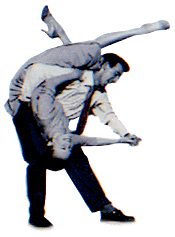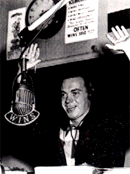INTRODUCTION: 1950'S ROCK AND ROLL
 It is
hard to believe, but there was once a time when there was no rock music.
Most historians trace the beginning rock back to the year 1954, when a new
type of music, then called Rock and Roll,
appeared and revolutionized musical tastes, at least among young people,
and pretty much changed the world.
It is
hard to believe, but there was once a time when there was no rock music.
Most historians trace the beginning rock back to the year 1954, when a new
type of music, then called Rock and Roll,
appeared and revolutionized musical tastes, at least among young people,
and pretty much changed the world.
This new music, of course did not develop in a vacuum, but resulted from the convergence of two musical styles, Rhythm and Blues and Country, as well as a series of technological developments that created a new market for music.
Rhythm and Blues developed from the music called the Blues. The Blues, to review what you have already learned in the Jazz unit, "grew out of African spirituals and work songs sung by African-Americans in the South. Many of these people had been brought to the United States as slaves, and before the Civil war they labored in difficult situations on the Southern plantations. 'Call and response' was often used as a means of communication by the workers in the fields, who fooled the plantation owners into thinking that their music was the 'happy' music of hard working slaves."
Rhythm and Blues developed from the Blues, and Rock and Roll developed from Rhythm and Blues (R&B). Little Richard, one of the great innovators in 1950's rock music, has often said that "Rhythm and Blues had a baby and somebody named it rock and roll." He, of course is absolutely right, and a number of important R&B artists were part of the beginning of Rock and Roll. Among them were Muddy Waters, Willie Mae Thornton, Joe Turner and Ray Charles.
While music was developing, technology was also changing. In the late 1940's and early 1950's, phonograph records were large and heavy and easily damaged. These records played at 78 rpm's (78 revolutions per minute) and were played on rather awkward record players that were usually part of a large piece of furniture (console), which often was located in the living room. Stereo had not yet been invented. In many homes, the entire family would sit around the living room listening to bands like Glen Miller, Tommy Dorsey and Benny Goodman, and soloists like Frank Sinatra, Patti Paige, Doris Day, and Eddie Fisher. Record companies marketed music to adults and radio stations played music that would appeal to the entire family.
In the 1950's, records began to change with the development of new technology that led to both the 33 rpm record and the 45 rpm record. The advantage of the new technology was that more musical information could be put on a record, and it was of higher technical quality. Thus, the 33 became popular because more music could be put on a 33 than several 78's and it sounded much better. The 45's were much smaller in size and contained one song on each side. These, as you might guess, were called singles. Not only were 45's much cheaper to buy than the old 78's and the larger 33's, but they could be played on a small record player that could be purchased inexpensively by a teenager and kept in his or her room.
This meant that there were now two markets for music, one for adults who bought mostly 33 rpm records and continued to play them on console phonographs and the other for young people, who bought mostly 45's and played them on small phonos in their rooms.
Also during this period, the "transistor radio" was invented and became popular. This meant that radios became much smaller and much less expensive, and like the small phonographs soon found their way to young people's rooms. Car radios were also becoming more popular, and more people were listening to the radio while driving. For a long time, the radio was an expensive option in a car. It is hard to imagine a car without a radio today, just as sometime in the not to distant future, it will be hard to imagine a car without a telephone. But in the 1950's radios were just beginning to become standard equipment in cars.
 Radio
stations began to program their music to fit the demographics of a new
audience. The audience, which until the early 1950's was a pretty
homogeneous audience, now was divided into segments with different
interests and people listened to music in a number of places, including
their cars. This all meant that some radio stations played music for
adults and some stations played music for the teens.
Radio
stations began to program their music to fit the demographics of a new
audience. The audience, which until the early 1950's was a pretty
homogeneous audience, now was divided into segments with different
interests and people listened to music in a number of places, including
their cars. This all meant that some radio stations played music for
adults and some stations played music for the teens.
Not surprisingly, young people were tired of the music their parents listened to and they started to look for something new. The white teens of the major metropolitan areas such as New York, Chicago, Detroit and Los Angeles began to turn to the stations that played music they had never heard before. It turned out that the music being played on the "black" radio stations in those cities was Rhythm and Blues (R&B). This music, was of course, familiar to the black population in America, but was brand new for many whites. Since the white audience was so much larger than the black audience, radio stations and record companies released that a major shift in listening patterns was about to occur, and in order to keep the white audience, as well as to appeal to the black audience, they needed to broadcast and promote R&B, or something like R&B.
Big Joe Turner's song "Shake, Rattle and Roll" began to be played on the white stations. The white record companies started looking for white acts (in the foolish belief, soon to be proved wrong, that white kids wouldn't buy records by black performers) that played something resembling R&B. Groups like Bill Haley and His Comets (originally a country band called the Saddlemen) and soloists like Elvis Presley brought a strong country background to the music, and this combination of R&B and Country became Rock and Roll.
These influences combined in a simple, blues-based song structure that was fast, sexy, catchy and could be danced to easily and with excitement. These qualities, along with the fact that it horrified adults in general and parents in particular, caused Rock and Roll to become immensely popular with teenagers, who then, for the first time had their own music.
Among the important bands and soloists in 1950's Rock and Roll were Willie Mae Thornton, Big Joe Turner, Bill Haley and His Comets, Chuck Berry, Elvis Presley, Little Richard, Jerry Lee Lewis, Buddy Holly and the Crickets, Fats Domino, Bo Diddley, Gene Vincent, the Everly Brothers, and Carl Perkins. Unfortunately, we can't cover all of them in this course, but we try to give you a representative group.
